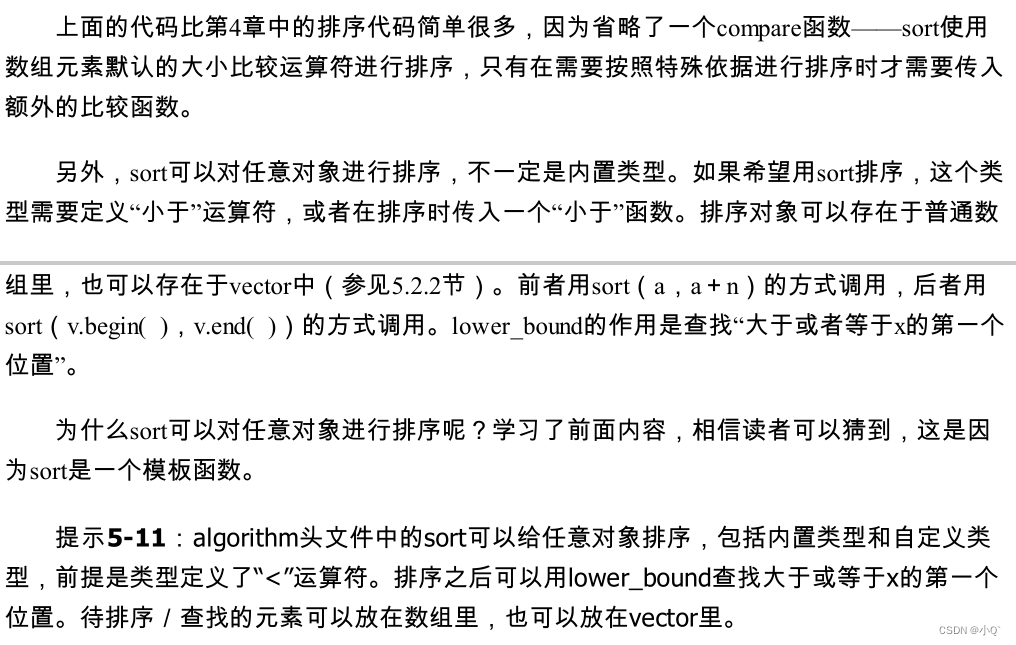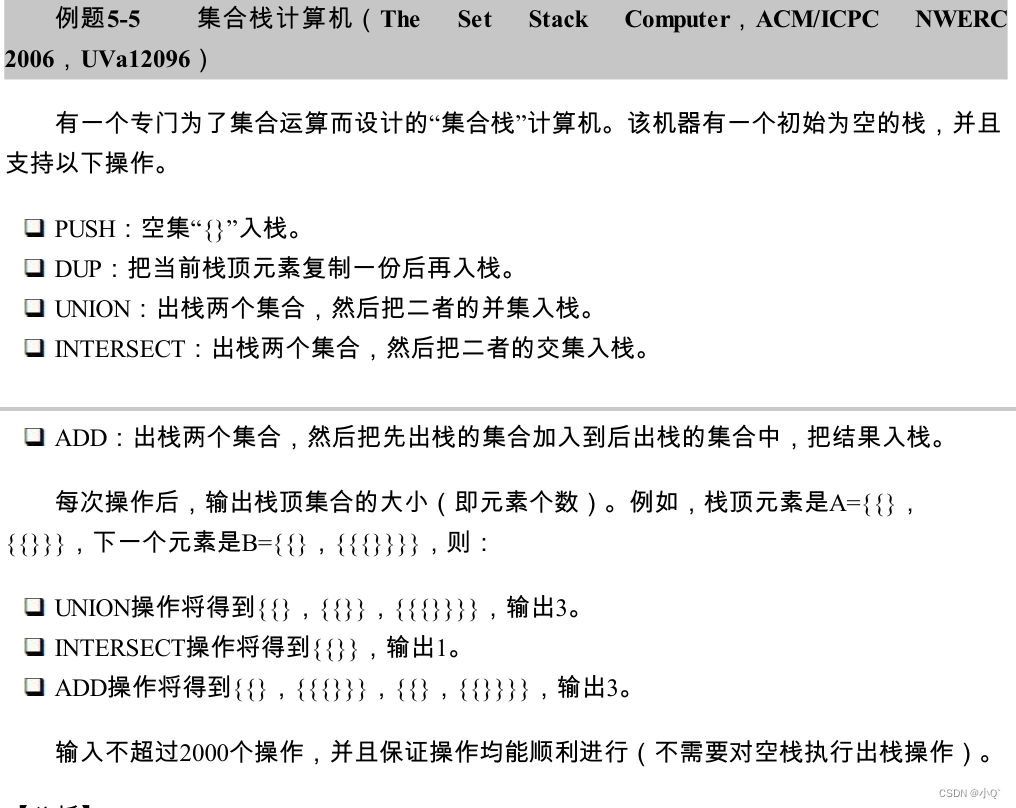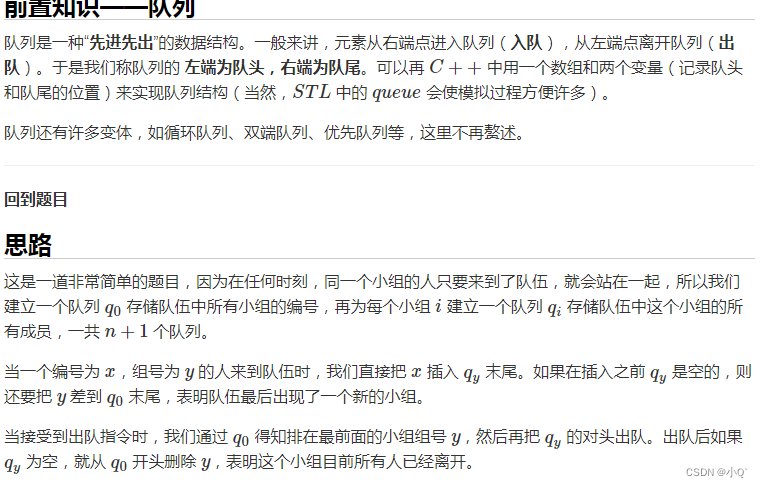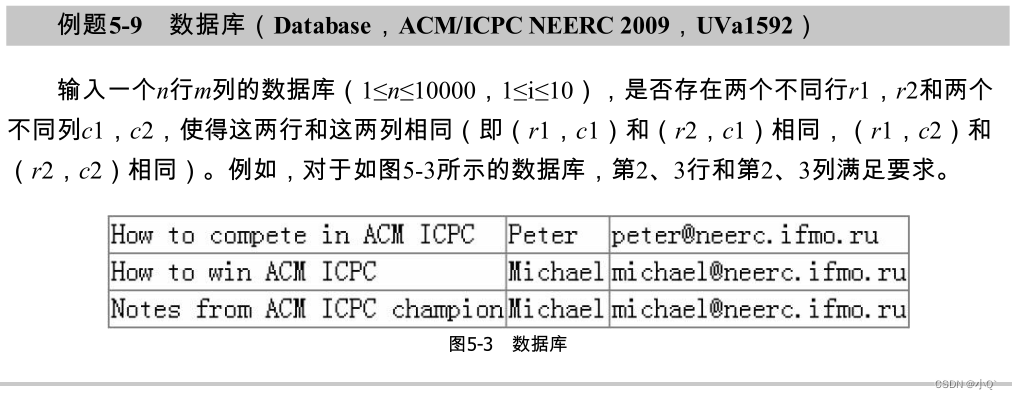提交地址: 算法竞赛入门经典(第二版)-刘汝佳-第五章 C++与STL 例题
中文题目地址:算法竞赛入门经典(第二版)-刘汝佳-第五章 C++与STL 例题与习题
5.1 从C到C++
5.2 STL初步
5.2.1 排序与检索
例题5-1:大理石在哪儿?
思路:
水题一道,直接暴力排序+检索即可。
代码:
#include <iostream>
#include <algorithm>
using namespace std;
const int N = 10010;
int a[N];//石头数组
int main()
{
int n, q, kase = 0;
//每次读入一个n,q。直到n,q都为0为止。
while(cin >> n >> q, n || q)
{ //对于每一组测试数据都要输出
printf("CASE# %d:\n", ++kase);
for(int i = 0; i < n; i ++) cin >> a[i];//读入每一个石头上的整数
sort(a, a + n);//升序
while(q--)//处理q个询问
{
int x;
cin >> x;
int idx = lower_bound(a, a + n, x) - a;//在已经排好序的数组a中寻找x;
if(a[idx] == x) printf("%d found at %d\n", x, idx + 1);
else printf("%d not found\n", x);
}
}
return 0;
}
总结:
- 下面三种函数的作用区间都是左闭右开。
- sort()函数:sort(start,end,cmp)。默认升序,start是要排序数组的起始地址,end是数组结束地址的下一位,cmp用于规定排序的方法,可不填,默认升序。
- lower_bound()函数:lower_bound(begin,end,num)的含义是从数组的begin位置到end位置-1位置二分查找一个大于或等于num的数字,找到则返回该数字的地址,不存在则返回end。通过返回的地址减去起始地址begin,可以找到数字在数组中的下标。
- upper_bound()函数:upper_bound( begin,end,num)的含义是从数组的begin位置到end-1位置二分查找第一个大于num的数字,找到返回该数字的地址,不存在则返回end。通过返回的地址减去起始地址begin,得到找到数字在数组中的下标。
- 不管起点下标是从0开始还是1,都应该减去的是a。

5.2.2 不定长数组:vector
例题5-2:木块问题
思路:
用vector定义一个二位数组,第一维表示是第几堆木块,第二维表示高度,pile[i][j]:表示为第i堆的第j个木块是哪个木块。
直接模拟操作。对于这四种操作,有很多的相似性。所以可以简化一下,不用每一种情况直接模拟。
代码:
#include <iostream>
#include <cstring>
#include <algorithm>
#include <vector>
using namespace std;
const int N = 30;
//创建n个木块的二维数组
vector<int> pile[N];
int n;
//找到块a,在哪一块上面和他的高度
void find_block(int a,int &p, int &h)
{
for(p = 0; p < n; p ++)
for(h = 0; h < pile[p].size(); h ++)
if(pile[p][h] == a) return;
}
//将p这一堆上面的移走
void clear_above(int p, int h)
{
for(int i = h + 1; i < pile[p].size(); i++)
{
int b = pile[p][i];
pile[b].push_back(b);//把木块b放回原位
}
pile[p].resize(h + 1);//p块只应保留下标0~h的元素
}
//将pa这一堆移到pb上面去
void pile_onto(int pa, int ha, int pb)
{
for(int i = ha; i < pile[pa].size(); i ++)
pile[pb].push_back(pile[pa][i]);
pile[pa].resize(ha);
}
//输出每一堆的情况。
void print()
{
for(int i = 0; i < n; i ++)
{
printf("%d:",i);
for(int j = 0; j < pile[i].size(); j ++) printf(" %d",pile[i][j]);
cout << endl;
}
}
int main()
{
//读入每一个操作
string s1, s2;
int a, b;
cin >> n;
//一开始每个块都只有自己这一块木头
for(int i = 0; i < n; i ++) pile[i].push_back(i);
while(cin >> s1 >> a >> s2 >> b)
{
int pa, pb, ha, hb;
//对于要操作的a,b,找到他们所在在块的编号和所在块的高度
find_block(a, pa, ha);
find_block(b, pb, hb);
//如果两个木块在一堆视为非法操作
if(pa == pb) continue;
if(s2 == "onto") clear_above(pb, hb);//如果为onto 则将Pb那一堆归位
if(s1 == "move") clear_above(pa, ha);//如果为move 则将pa那一堆归位
pile_onto(pa, ha, pb);
}
//输出答案
print();
return 0;
}
总结:

5.2.3 集合:set

例题5-3:安迪的第一个字典
思路:

代码:
#include <iostream>
#include <algorithm>
#include <set>
#include <string>
#include <sstream>
using namespace std;
set<string>dict;//string 集合
int main()
{
/*
stringstream的用法:当读入一个字符串s为"hello".的时候,我们想要的只是hello而不是"hello".
所以这个时候,我们只需要把其中的非字母的标点符号全部转成空格。
然后用stringstream再对s进行读入。就不会读入空格,只能得到hello
*/
string s, buf;
while(cin >> s)//一直读入一个字符串,读到不能读
{ //对于字符串s的每一字符判断一下是否是英文字符,是的话就转成小写,不是则转成空格。
for(int i = 0; i < s.length(); i ++)//为什么转小写字母是因为单词都是小写,只有句子首单词才大写首字母。
if(isalpha(s[i]))//如果当前这个字符是英文字符的话 就转成小写字母否则改为空格。
s[i] = tolower(s[i]);
else s[i] = ' ';
//转换之后,s就从之前的含有""、.各种标点符号的字符串,转换成一个只有英文字符和空格的字符串。
//此时,再用stingstream对s进行重读入即可得到单词。
stringstream ss(s);
while(ss >> buf) dict.insert(buf);
}
for(auto a : dict) cout << a << endl;
return 0;
}
总结:
- 其中stringstream的用法很关键,需要掌握。
- set里面的数据自动从小到大排序。
- isalpha()函数:isalpha(s[i])判断s[i]是否是英文字符。
- tolower()函数:tolower(s[i])将s[i]转成小写字母。
5.2.4 映射:map

例题5-4:反片语

思路:
把每一个单词标准化,全部转为小写字母后再排序,然后再放到map中统计。
一个单词能通过字母重排得到另外一个单词 当且仅当 这两个单词 标准化之后 是相同的。
代码:
#include <iostream>
#include <algorithm>
#include <cstring>
#include <map>
#include <vector>
using namespace std;
vector<string>words;//存储每一个单词
map<string,int>cnt;//单词标准化之后的映射
//将字符串s 标准化,转成小写字母排序
string repr(string s)
{
for(int i = 0; i < s.length(); i ++)
s[i] = tolower(s[i]);
sort(s.begin(), s.end());
return s;
}
int main()
{
int n = 0;
string s;
while(cin >> s)
{
if(s[0] == '#') break;
words.push_back(s);
string r = repr(s);//将当前单词标准化.
// if(!cnt.count(r)) cnt[r] = 0;
cnt[r] ++;//标准化之后的放入map计数
}
vector<string>ans;//存储答案
for(int i = 0; i < words.size(); i ++)
{ //如果当前这个单词标准化之后只出现一次,
if(cnt[repr(words[i])] == 1) ans.push_back(words[i]);
}
//将答案数组排个序
sort(ans.begin(),ans.end());
for(int i = 0; i < ans.size();i ++)
cout << ans[i] << endl;
return 0;
}
总结:
- 结论:一个单词能通过字母重排得到另外一个单词 当且仅当 这两个单词 标准化之后 是相同的。

5.2.5 栈、队列与优先队列

例题5-5:集合栈计算机

思路

代码
#include <iostream>
#include <algorithm>
#include <stack>
#include <set>
#include <map>
#include <vector>
using namespace std;
#define ALL(x) x.begin(),x.end()
#define INS(x) inserter(x,x.begin())
typedef set<int> Set;//把set<int>重定义为Set。
map<Set,int> IDcache;//把集合映射为ID
vector<Set>Setcache;//根据ID取集合
int ID(Set x)
{
if(IDcache.count(x)) return IDcache[x];
Setcache.push_back(x);
return IDcache[x] = Setcache.size() - 1;
}
int main()
{
int t;
cin >> t;
while(t --)
{
stack<int>s;
int n;
cin >> n;
//n个操作
for(int i = 0; i < n; i ++)
{
string op;
cin >> op;//读入每次操作的指令。
if(op[0] == 'P') s.push(ID(Set()));
else if(op[0] == 'D')s.push(s.top());
else
{
//否则都要出站两个集合。
Set x1 = Setcache[s.top()];s.pop();
Set x2 = Setcache[s.top()];s.pop();
Set x;
if(op[0] == 'U') set_union(ALL(x1), ALL(x2), INS(x));//如果是U则把两个集合的并集入栈
if(op[0] == 'I') set_intersection(ALL(x1), ALL(x2), INS(x));//如果是I则把两个集合的交集入栈
if(op[0] == 'A')
{
x = x2;
x.insert(ID(x1));
}
//不管怎么样都要把x入队
s.push(ID(x));
}
cout << Setcache[s.top()].size() << endl;
}
cout << "***" << endl;
}
return 0;
}
总结
1.巧妙使用宏定义
#define ALL(x) x.begin(),x.end()
#define INS(x) inserter(x,x.begin())
2.set的两个内置函数
set_union():求并集
set_intersection():求交集
3.把每一个集合set分配一个编号。
例题5-6 团体队列
思路:


代码:
#include <iostream>
#include <algorithm>
#include <queue>
using namespace std;
const int N = 1010, M = 1000010;
int teamid[M];
int main()
{
int n, c = 1;
while(cin >> n, n)
{
queue<int>team;//维护队列之间的关系
queue<int>person[N];//每个小组的人
printf("Scenario #%d\n", c++);//每个数据输出一个
//处理输入
for(int i = 0; i < n; i ++)
{
int cnt;
cin >> cnt;
while(cnt --)
{
int x;
cin >> x;
teamid[x] = i;//第x个人的属于第i组
}
}
string command;//命令
while(cin >> command, command != "STOP")
{
if(command == "ENQUEUE")
{
int x;
cin >> x;
int tid = teamid[x];//得到第x个人的小组编号
if(person[tid].empty()) team.push(tid);
person[tid].push(x);
}
else
{
int tid = team.front();//取第一个小组的编号.
auto &q = person[tid];
cout << q.front() << endl;
q.pop();
if(q.empty()) team.pop();
}
}
cout << endl;
}
return 0;
}
总结:
- 队列插队模型。开辟M个队列维护同一个小组之间的关系,再开一个队列维护小组之间的关系。
例题5-7:丑数

思路:
通过唯一分解定理可以证明。所有的丑数
N
=
2
c
1
∗
3
c
2
∗
5
c
3
N = 2^{c_1} * 3^{c_2} * 5^{c_3}
N=2c1∗3c2∗5c3。

代码:
#include <iostream>
#include <set>
#include <queue>
using namespace std;
typedef long long ll;
int a[3] = {2, 3, 5};//每次乘2 乘3 乘5
int main()
{
priority_queue<ll , vector<ll>, greater<ll>> heap;//优先队列
set<ll>s;//有时候会得到重复的数据
heap.push(1);
s.insert(1);
for(int i = 1; ;i ++)
{
ll x = heap.top();heap.pop();
if(i == 1500)//第1500出队的数就是答案
{
cout << "The 1500'th ugly number is " << x << ".\n";
break;
}
for(int j = 0; j < 3; j ++)
{
ll x2 = x * a[j];
if(!s.count(x2))//判重
{
heap.push(x2);
s.insert(x2);
}
}
}
return 0;
}
总结:
- 用集合set判重是一个重要的方法。

5.3 大整数类
就是高精度算法。
5.4 竞赛题目举例
例题5-8: Unixls命令
思路:

注意本题是竖着输出的。
代码:
#include <iostream>
#include <algorithm>
#include <string>
using namespace std;
const int maxcol = 60;
const int maxn = 100 + 5;
string filename[maxn];
void print(string s, int len, char ch)
{
cout << s;
for(int i = 0; i < len - s.length(); i ++)
cout << ch;
}
int main()
{
int n;
while(cin >> n)
{ //求最大的长度M
int M = 0;
//读入每个文件的名字
for(int i = 0; i < n; i ++)
{
cin >> filename[i];
M = max(M, (int)filename[i].length());
}
print("-", 60, '-');//输出函数
cout << endl;
int col = (maxcol - M) / (M + 2) + 1;//得到总列数。
int row = (n + col - 1) / col;//得到总行数 向上取整。
sort(filename, filename + n);//将单词排序
//输出对应的单词 二维转化成一维
for(int r = 0; r < row; r ++)
{
for(int c = 0; c < col; c ++)
{
int idx = c * row + r;//将二维坐标转成一维坐标
if(idx < n) print(filename[idx], c == col - 1 ? M : M + 2, ' ');//如果存在就输出
}
cout << endl;
}
}
return 0;
}
总结:
- 有些时候用输出函数会更加简洁。
- 二维数组下标转换成一维数组下标(下标都从0开始):a[i][j] = a[j * row + i](竖着) a[i][j]=a[i*col+j](横着)
例题5-9:数据库

思路:

代码:
#include <bits/stdc++.h>
using namespace std;
int n, m;
string s, st;
map<string, int>idmp;//将字符串->id
int getID(string s)
{
if(idmp.find(s) == idmp.end()) idmp.insert({s, idmp.size()});
return idmp[s];
}
int main()
{
while(cin >> n >> m)
{
getchar();//读入回车符
vector<int>table[n + 1];
idmp.clear();//初始化
for(int i = 0; i < n; i ++)
{
getline(cin, s);
stringstream input(s);//定义一个stringstream流
while(getline(input, st, ',')) table[i].push_back(getID(st));
}
bool flog = true;
for(int i = 0; i < m - 1 && flog; i ++)
for(int j = i + 1; j < m && flog; j ++)
{
map<pair<int,int>,int>pos;//两列对应字符串标号->行
for(int k = 0; k < n && flog; k ++)//遍历每一行
{
if(pos.find({table[k][i], table[k][j]}) == pos.end()) pos[{table[k][i], table[k][j]}] = k;
else
{
printf("NO\n%d %d\n%d %d\n", pos[{table[k][i],table[k][j]}]+1, k+1, i+1, j+1);
isPNF = false;
}
}
}
if(flog) printf("YES\n");
}
return 0;
}
总结:
- 本题值得注意的是用map实现将每个字符串赋值一个ID。






















 412
412











 被折叠的 条评论
为什么被折叠?
被折叠的 条评论
为什么被折叠?








